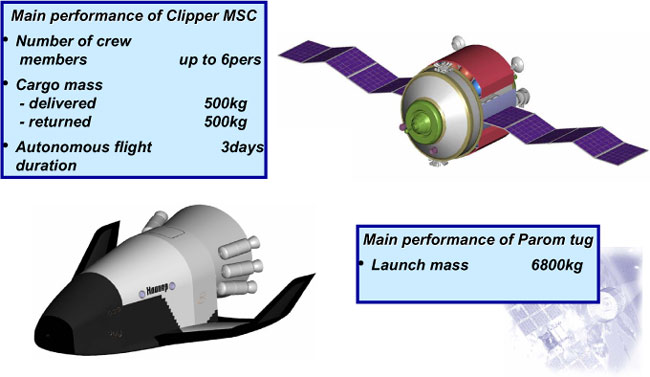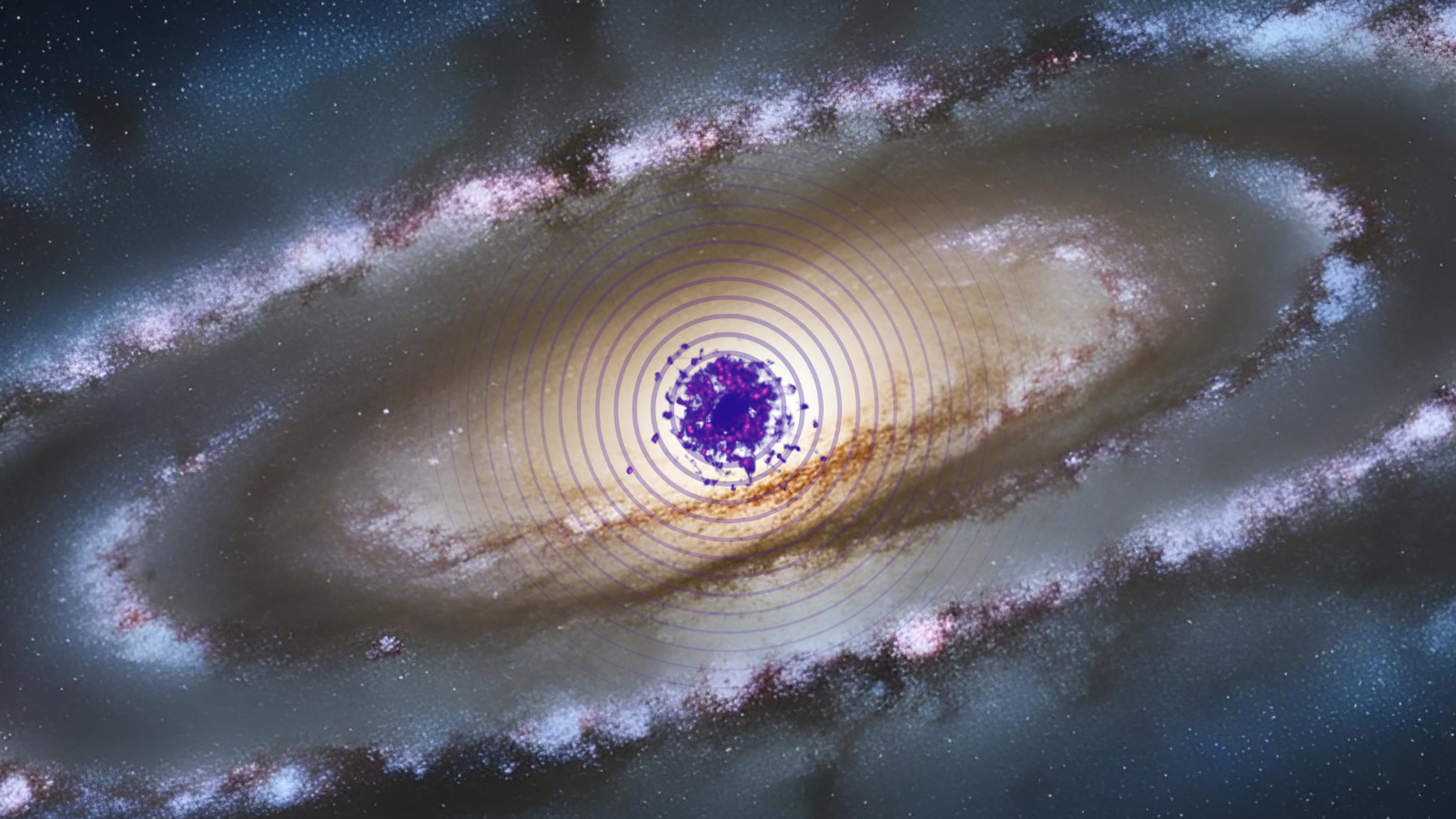Russia's Next Spaceship: Alternative to NASA's CEV

As NASA prepares to once again send humans to the surface of the Moon, Russia is also developing its own plans for future manned spaceflight.
The country's Clipper project to develop a six-person spacecraft to deliver astronauts into Earth orbit, and potentially beyond, appears in some ways to be the Russian Federal Space Agency's answer to NASA's Crew Exploration Vehicle (CEV).
"We're starting to design this new transportation system to support the International Space Station (ISS) once it's complete," said Nikolay Sevastiyanov, president of the Russian aerospace contractor RSC-Energia, during a recent space conference where the program was discussed.
The winged crew vehicle, Clipper, would launch atop a Russian Soyuz 2-3 booster and could form the heart of potential Moon- or Mars-bound craft, according to RSC-Energia designs. Separate cargo pods could also launch atop a separate Soyuz rocket. Both the Clipper vehicle and cargo pods would be towed to the ISS.
Outside participation in the project by the European Space Agency (ESA) appears on hold after ESA ministers decided this week not to fund a two-year, $59.8-million (51-million euro) trial to study Clipper with the Federal Space.
Last month, however, Federal Space Agency officials said they expected the Russian government to invest up to $795 million (23 billion rubles) in the Federal Space Agency in 2006, from which the Clipper program and others will draw their funds. Japanese space officials are also discussing whether to join the Clipper effort, according to ESA officials.
While the ESA has no current plans to join Russia's Clipper program, agency officials have said such an alternative access to the ISS would be a valuable tool. NASA space shuttles and Russian Soyuz vehicles are currently the only spacecraft capable of launching humans to the station.
Breaking space news, the latest updates on rocket launches, skywatching events and more!
"The availability of more than one transportation system offers a robustness that has great advantage over reliance on a single system," said Alan Thirkettle, head of ESA's human spaceflight, microgravity and exploration directorate, who detailed the Clipper during the November conference. "We would like an independent way of getting access to the International Space Station (ISS)."
Thirkettle told SPACE.com that should ESA officials later decide to join the Clipper program, the involvement would allow European astronauts guaranteed access to the ISS instead of requiring the purchase or barter of a seat aboard a Soyuz vehicle.
A multi-vehicle system
Like NASA's current space vision, which separates astronaut crews and cargo into two launch vehicles that rendezvous in orbit, Russia's Clipper program is also divided into a two-rocket job.
But instead of the two different launchers required for NASA's current lunar exploration plan, Russian and ESA officials expect to launch crew and cargo atop variants of the Soyuz 2-3 rocket.
"It's really an end-to-end space system, not just a vehicle," Thirkettle said, adding that current plans call for Clipper launches from the veteran crew launch platform at Baikonur Cosmodrome in Kazakhstan or Europe's Guiana Space Center in Kourou, French Guiana.
According to ESA and RSC-Energia, Clipper would not be able to reach the ISS on its own.
Instead, plans call for a space tug dubbed Parom to swoop down from the space station, latch up the crew-carrying spacecraft, and then tow it to a berth along the Russian segment of the ISS.
A space tug
While Clipper is slated to deliver astronauts and 1,102 pounds (500 kilograms) of cargo to the ISS, a Parom-compatible, unmanned supply ship could deliver 15 tons (13,607 kilograms) of material to the orbital platform, Thirkettle said.
Russian space officials hope Clipper will lower ISS flight costs and reduce the stress on passengers - by lowering g-force pressure during launch - in order to boost space tourism and research.
"If we hit those requirements, no longer will just professional cosmonauts and astronauts from the various space agencies be able to reach the ISS, but also researchers," Sevastiyanov said. "Only proper researchers will be able to conduct space science experiments with the proper amount of exactitude."
Clipper will have some sort of heat shield to protect it during fiery atmospheric reentries during descent, but a final decision remains to made, Russian space officials said.
"It's not going to be the kind of thermal protection system that we used on the Soyuz vehicle," Sevastiyanov said. "We're going to make a [future] decision as whether or not to use tile."
Current Soyuz-TMA spacecraft use an ablative coating to ward off the searing heat of reentry while NASA's shuttles are lined with heat-resistant tiles and reinforced carbon-carbon panels.
Aiming higher
While Russia's planned Clipper system's largest advantage would be the delivery of humans into orbit, Russian space officials hope the vehicle may prove more flexible for more lofty exploration missions.
"Clipper could also support exploration of the Moon," Thirkettle said, adding that a crew vehicle could link up with a lunar lander and cargo craft in Earth orbit much like NASA's CEV plan. "The concept could even be aimed at going much further."
In one RSC-Energia concept, Clipper forms a hub surrounded by solar arrays, propulsion systems and other hardware arranged for a Moon-bound or interplanetary flight.
"We're starting to look at the moon as a source of fuel," said Sevastiyanov, referring to why humans should push out into space. "Maybe it's science fiction right now, but we need to start moving in that direction."

Tariq is the award-winning Editor-in-Chief of Space.com and joined the team in 2001. He covers human spaceflight, as well as skywatching and entertainment. He became Space.com's Editor-in-Chief in 2019. Before joining Space.com, Tariq was a staff reporter for The Los Angeles Times covering education and city beats in La Habra, Fullerton and Huntington Beach. He's a recipient of the 2022 Harry Kolcum Award for excellence in space reporting and the 2025 Space Pioneer Award from the National Space Society. He is an Eagle Scout and Space Camp alum with journalism degrees from the USC and NYU. You can find Tariq at Space.com and as the co-host to the This Week In Space podcast on the TWiT network. To see his latest project, you can follow Tariq on Twitter @tariqjmalik.
